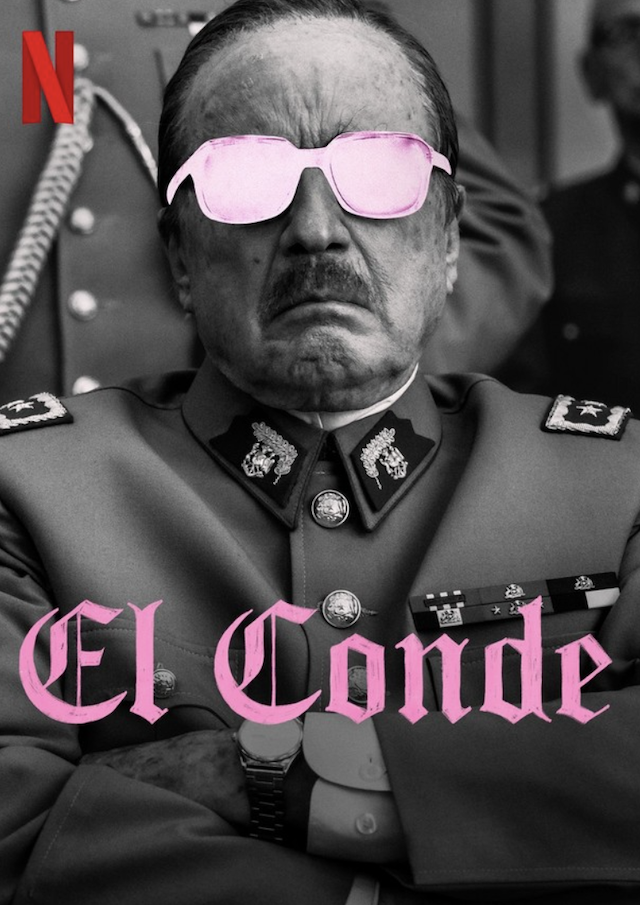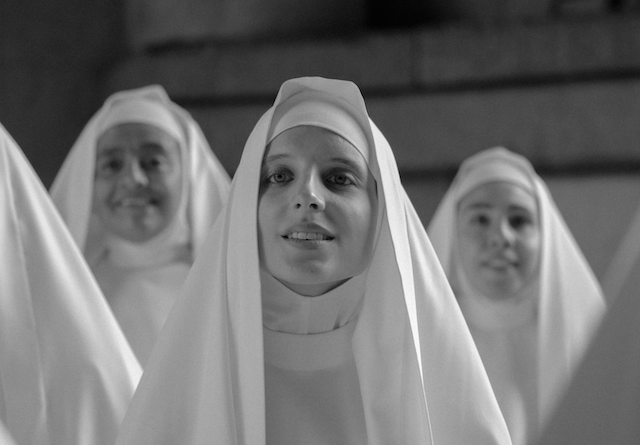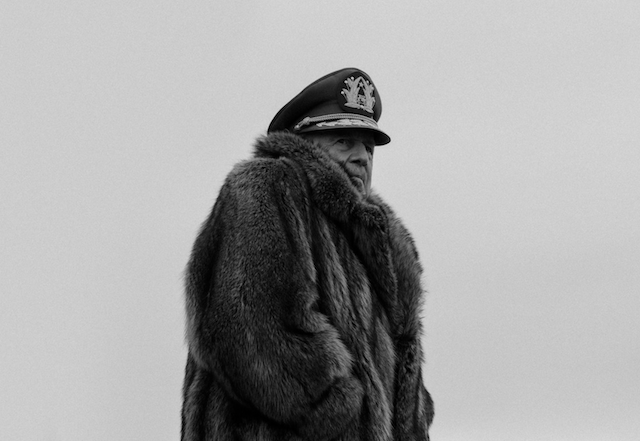
© 2023 Netflix, Inc.
El Conde is a dark comedy/horror that imagines a parallel universe inspired by the recent history of Chile. The film portrays Augusto Pinochet, a symbol of world fascism, as a vampire who lives hidden in a ruined mansion in the cold southern tip of the continent. Feeding his appetite for evil to sustain his existence. After two hundred and fifty years of life, Pinochet has decided to stop drinking blood and abandon the privilege of eternal life. He can no longer bear that the world remembers him as a thief. Despite the disappointing and opportunistic nature of his family, he finds new inspiration to continue living a life of vital and counterrevolutionary passion through an unexpected relationship.
Rating: R (Sexual Content|Rape|Language|Some Graphic Nudity|Strong Violence and Gore)Genre: Comedy, HorrorOriginal Language: Spanish
Director: Pablo Larraín
Producer: Juan de Dios Larraín , Rocío Jadue
Writer: Guillermo Calde, Guillermo Calderón, Pablo Larraín
Release Date (Theaters): Sep 8, 2023 Limited
Release Date (Streaming): Sep 15, 2023
Runtime: 1h 50m
Distributor: Netflix
Production Co: Fabula

Photo by Mary Cybulski – © Courtesy of Amazon Studios
Q&A with a Legendary Cinematographer Edward Lachman
Q: It’s an amazing movie and your collaboration [produced] a timeless classic. How did your collaboration get started on this movie? You’ve been friends but haven’t collaborated on something before.
Edward Lachman: I like looking at films as much as working on them, maybe more. I first saw Pablo’s work, “Tony Manero,” at the New York Film Festival and from there we developed a friendship. He said, “One day, I’ll bring you to Chile” but I never thought that was actually going to happen. We were always friendly. He came to New York and worked with Darius Khondji who is a friend. So I thought, “wow, he comes all the way to New York and works with a French cameraman, why does he need to bring me to Chile?” We did a commercial in Los Angeles and he called me about a month later and said, “would you come to Chile?” Sure. But obviously, I don’t speak much Spanish and I’ve worked with his whole crew and right from the beginning, he said he wanted to work in black and white.
Today you usually have to shoot in color, either in film or digitally and then transfer it into a monochromatic image. But he convinced Netflix, that it be produced out of Mexico, and he was going to shoot in black & white. That opened up a whole door for me and I reached out to Arriflex, the camera manufacturer in Germany. I knew they had produced a large format camera for monochromatic but not a lighter weight camera. Another conceit that he wanted to do was to be on a crane for the whole time — a short 15 ft Technoscope telescopic crane. His idea was that we could move quicker and find angles. That set was built for the size of the crane so we could move in and not have to take out walls. We did once or twice. There were all those factors that came into it. Ari was just coming out with their own camera and I thought they’d never get there even if they were interested.
Lo and behold, 10 days before we were to shoot, they said we have a camera for you. I went back to Pablo and said, “We have a camera. Can the production afford it?Z” Well, he’s the production company, so he said yes. Another aspect of the filming was that I worked with lenses that were actually made in the ’30s for black & white. They were the primary lenses that shot black & white film. I just happened to remount those lenses for somebody who had told me that in L A about this glass that was available. Now I have the black & white lenses, the black & white sensors. all these things contributed and then there’s an exposure system that I used for the first time.
Q: That’s the system that you invented.
Edward Lachman: Basically I don’t make it complicated. If you knew Ansel Adams, he developed a way of evaluating exposure. You could read shadow detail and highlights and place your negative where you would get the most detail, which is a way of analyzing where your exposure was. I worked on an idea about doing that for digital technology. I was, again, very lucky — all the forces came together when a monitor company, SmallHD, came out with this inner monitor and they licensed it to me. I was able to use it for the first time in this film.
That’s why you have this incredible shadow detail that you would lose if you didn’t know where you were placing your eye light. Sometimes, if you overexpose something, you have to print it down and then you don’t get the shadow detail. I was thinking about looking at it today — what’s the difference? Matthew Libatique shot “Maestro” in color then converted to black & white. You don’t get the subtlety of midrange that you can get when you shoot monochromatic. The other thing is you can use filters that they used 50 years ago, black and white filters that you can’t use on color film. You can try to do it in post, but it’s not the same thing.
Q: It sounds like the perfect marriage of technique and intention to create this look that’s both timeless and there’s a purposeful artificiality to it. You have worked in black & white before for some of Todd Haynes’ films like “Wonderstruck.” Give us a taste of what’s more appealing to you in shooting in black and white, something maybe you get when you’re not working in color.
Edward Lachman : When you shoot in color, you have a problem with the color temperature of the day. it changes. The amazing thing is that I realized that, again with black & white, because I hadn’t shot black and white since “Wonderstruck.” However, that was with film and this is digital. The amazing thing is that what’s wonderful about black & white is that you can shoot from the beginning of the day to the end of the day and it’s just contrast. It’s light and dark. In color, the color temperature changes from cool to warm, to cool to warm changes and you have to modify what you’re doing with color. They always say black & white is harder because you don’t see black & white so you have to imagine how it will look.
Once your eye gets more trained and, especially, when you’re looking at it on a monitor, you can affect how the black & white [works]. We tested different colors for blood and ended up with blue, All the blood is blue because we found it had more luminosity. when I was in the hospital with my broken hip, at the end of the show, I found out that in our body, that’s why our veins look blue. Our blood is blue and it’s only red when it hits the air.

© 2023 Netflix, Inc.
Q: Let’s go back to the beginning when you first were presented with the concept of Augusto Pinochet as a 250 year-old vampire. What was your reaction and what pulled you into the story?
Edward Lachman: Pablo was my education and the way he expressed it was that Chileans have never been able to heal because they never had the justice to heal. The individuals and their families paid the price. Even the church… There was a part of the church that did fight what Pinochet was doing to the people. there was another part of the church that went along with him. When he explained it that way, I understood why he is forever. He died a multimillionaire and died free. Which is why the Chilean people will never be able to have any resolution to the crimes that were committed. Not like in Argentina where the [dictator] goes to jail.
Q: He’s embarrassed about being called a thief, but he’s not embarrassed about the murders. He thinks of them as a necessity. what kind of [perhaps] hemophiliac conversations you and Pablo had watching this movie. Obviously, that recalls “Nosferatu,” “Vampyr.” What other movies have you visited?
Edward Lachman: I looked at those films — “Vampyr,” “Nosferatu” by F.W. Murnau, and I did like Josef von Sternberg. In some ways, I liked working on films where I don’t speak the language because then I can just look at it, in my own world. Things came together in abstract ways, there wasn’t much of an intellectualization.
Q: What did you bring to the table to make plausible the scenes of Pinochet flying over Santiago.
Edward Lachman: All the night footage is against the blue screen or green screen. All the day scenes, they brought in — and I didn’t even know about this — an acrobatic group from Colombia that worked on wires. One of our actresses Paula [Luchsinger] had studied dance so they put her on wires. We did have a stunt double and it was a 160 ft crane and in the middle of the crane was a seat on cable. The operator allowed us to show that double or Paula flying or moving around that landscape — it was a sheep farm in Patagonia. That’s real air-to-air photography without the benefit of drones. We did use a drone for the point of view of when they’re flying. The drone was the second unit and they went out to film in areas all over Chile. I was there on a vacation watching what was happening.
Q: What’s your process with the other departments like production and costume design, especially when you’re shooting in black & white. What is the harmony among the other technical departments?
Edward Lachman: The production designer there didn’t speak any English and they work a little differently. Generally, I have an on-set prop person moving things around through the frame. But there he came out of the theater, he had no compulsion but to be on the set all the time and move things around. But wait a minute, that’s my set now but we got along even though sometimes we had discussions through Pablo like, “Don’t move that or move that.”
When I’m working on a set, it’s what’s in the frame that’s important to me, how you compose the frame, and how you move the image in the set. Your great production designer actually thinks about the frame when they design the set. He had a little different approach to it, more like theater. There’s the stage and the set and you just work with it. We did all this testing with lighting which made the backgrounds always dark because I wanted that separation between the characters and the background so that there was a starkness to it.
I did something different that I don’t normally do. Even though there was an overhead bridge system for lighting, I mostly lit from the window and because we moved the camera around a lot, I couldn’t have lights on in the set to help their eyes out. But I realized something that these people are hiding from themselves and hiding from each other. I let the eyes go darker than I ever normally would do and it worked. First, I thought it was a mistake, but here the eyes go in the shadow from cross light and it was important psychologically for the characters.

© 2023 Netflix, Inc.
Q: What was something specifically difficult during the filming? What sequence was most challenging to get right?
Edward Lachman: There were these big lights that I like to use and nobody wanted to say no to me. So if I say I want eight 10Ks around the set. On pre light day I would be there and the lights would not be there. They always promise they would be available ‘mañana’ but they never do. I finally had to adapt to work with the equipment that I had. That was an improvement. if I had everything I wanted, I wouldn’t have done it.
Q: Over your career, you’ve collaborated with so many and shot across genres. Do you have a filmmaker that you’d still love to work with, who would that be?
Edward Lachman: I went to art school and then ended up being a cinematographer, a cameraman for other people’s films. I’ve always made some of my own films. There’s always new people, I’m always inspired when I see other people’s work, even other cinematographers. There’s a reason why people create images the way they do because of the time period. That’s something that Todd Haynes is very much into. He understands that the tools you use affect the look of the final image.
On “Wonderstruck” he wanted to use the same apparatus of the periods (‘70s and the ‘20s) like the dollies used to get those long tracking shots in the street and not see the track. We used something called the Western dolly that has rubber wheels, it was not the best way to do it, but was the only way during that time period. I always find it interesting to go deeper into how it’s done and why it’s done. I studied painting, studio art and didn’t like the idea that I’d be alone in a room. If someone brings me a story, I like the challenge of finding the visual language to tell that story.
Q: Speaking of different techniques and tools that are available, there’s obviously so many changes in the way films are shot. Some people still swear by film and others love the flexibility and freedom that digital brings to the table. Where you stand?
Edward Lachman: I used to always think it has to be film but the way I feel about it now, certain stories can be told in the film, some can be done digitally. The problem is it has become more and more difficult for student films. The craft of filmmaking is being lost because during the process you need a film loader, someone that loads the film in the magazine. younger and younger people aren’t coming up in the industry learning how to load film anymore.
Film labs don’t have some of the equipment anymore that helps judge the treatment for the film negative. Footage gets mistreated during digital transfer. The old classic cameras don’t get repaired properly because of the lack of expertise and replacement parts. To continue shooting on film, we’re going against what the industry is pushing because that’s the way they make more money. They come out with faster lenses, higher-resolution cameras, actual image makers don’t necessarily want everything to look photorealistic. Sometimes it’s essential for us to feel that we are actually watching a film and not be inside the storyline.
Check out more of Nobuhiro’s articles.
Here’s the trailer of the film.

